Pre-season training
This is very much a generic pre-season training session focused on fitness. It’s built around the fitness requirements of the players but it is delivered through a normal training session that the team enjoy. We incorporate technical practices with crossing and finishing, and we include possession work before concluding the session with small-sided games.

| Area | Up to half a pitch |
| Equipment | Balls, bibs, cones, poles, 4 goals |
| No. of Players | 18 players + 2 goalkeepers |
| Session Time |
Technical practice: 15mins, Crossing & finishing: 20mins, Four goal game: 30mins, Small-sided games: 20mins |
This is very much a generic pre-season training session focused on fitness. It’s built around the fitness requirements of the players but it is delivered through a normal training session that the team enjoy. We incorporate technical practices with crossing and finishing, and we include possession work before concluding the session with small-sided games.
The input of our sports science team is extremely important to ensure the loading and recoveries are appropriate for the outcomes that we are seeking from the session.
What do I get the players to do?
Technical practice
This practice is made up of two elements, with players rotating between three roles: working, serving and recovery. We set up an area of 45x45 yards for one part of the practice and an area of 10x10 yards for the other part. We’re using 18 players divided into three teams of six.
Two teams start in the larger of the areas, set up as shown [1a], with six blue working players in the centre surrounded by a ring of six red servers, each one standing in front of a pole with a ball. The working players make runs towards the servers, who play a one-two with them. The working players then run around the pole and sprint towards another server for a one-two, as shown [1b]. The working players should reach as many servers as possible in each 45-second block.
1a
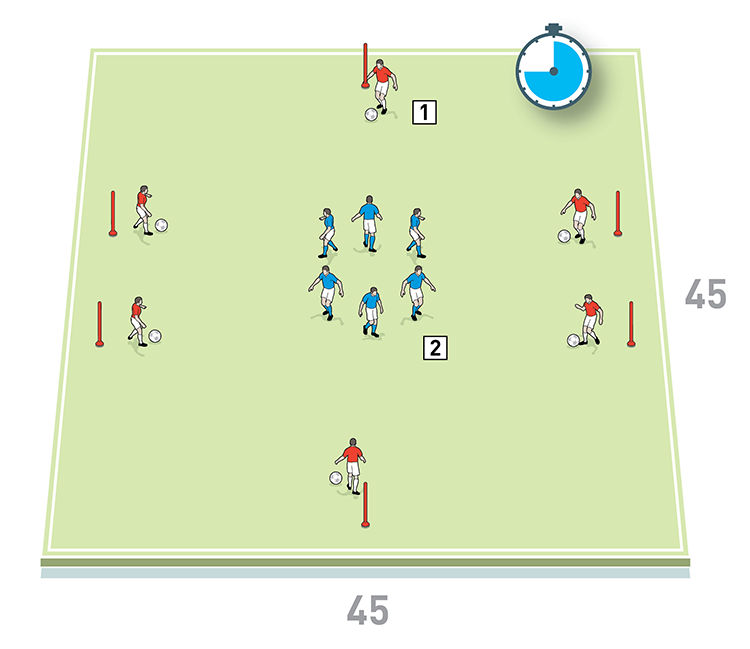
2. The blues start as the working players
1b

2. After executing the technique, they run around the pole and sprint to another server to perform the technique again
3. The working players are all active at the same time and must visit as many servers as they can in each 45-second block. Set them different technical demands for each block
Each team is in the working role for six blocks, and we set them a different technical demand for each block (such as a one-two, volley, header, left foot pass, right foot pass). After six 45-second blocks, the three teams rotate roles.
While two of the teams are running this drill in the larger of the areas, the third team is in the small area on active recovery, juggling a ball for the duration of the six blocks, as shown [1c].
1c
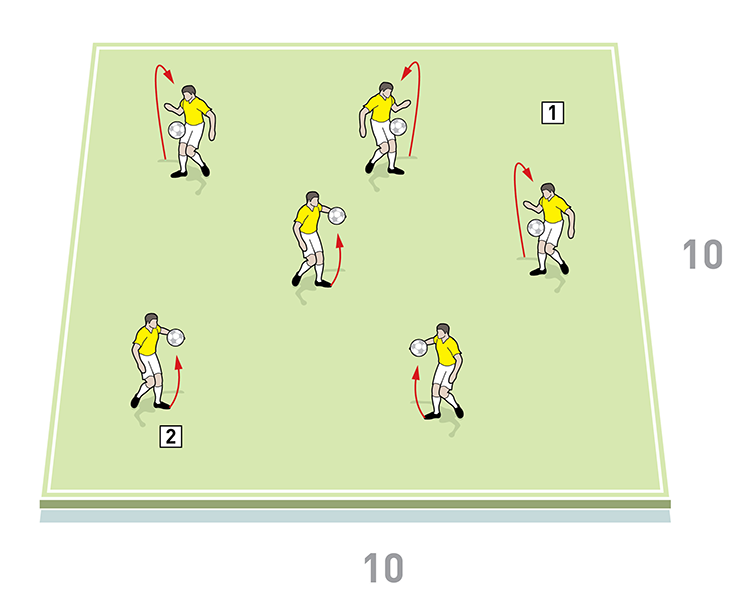
2. The team is on active recovery, with players juggling a ball for the period that another team is working. Then teams swap roles
Crossing & finishing
We set up on half a pitch with a goal and a goalkeeper at each end and six poles positioned, as shown [2a]. We’re using 18 outfield players, split into three teams of six. One team (the yellows) act as bounce players and crossers and they start with one on each pole. The other two teams (the reds and the blues) work on passing and movement to score goals, with one of the teams starting at each end of the area.
2a
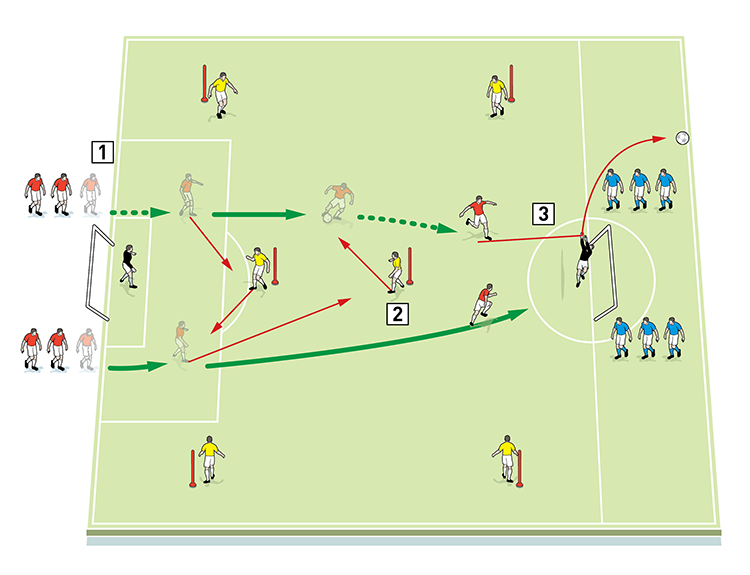
2. They build the attack by playing wall passes with the yellows
3. The first attack finishes with a dribble and a shot but the pair must be alert to follow up on any loose balls
The red team sends the first pair to attack, building their move with the help of the yellow players on the poles and finishing with a dribble and a shot. They must also be alert to any loose balls in front of goal.
After shooting, the red pair must turn and sprint towards the end they started to meet a ball delivered by one of the crossers, as shown [2b]. After finishing their second attack, the red pair return to the back of their starting queue. Then the first blue pair start an attack from their end.
2b

2. One of the yellows crosses the ball and the red pair must try to get on the end of it to shoot and to follow up on any loose balls
3. After shooting the red pair return to the back of the queue
4. The first blue pair launch an attack from the other end
This is aerobically challenging and sets high demands of the players in terms of passing, shooting, crossing and finishing, so work to a set number of attacks per pair.
Four goal game
We set up an area of 25x25 yards with a goal on each side, although the size of the area can vary according to the physical requirements needed. Again, we’re using three teams of six. Two teams pass to keep possession, while the third team presses to win the ball and if they succeed, they must try to score in any of the four goals, as shown [3]. We make sure we keep a note of the scores.
3
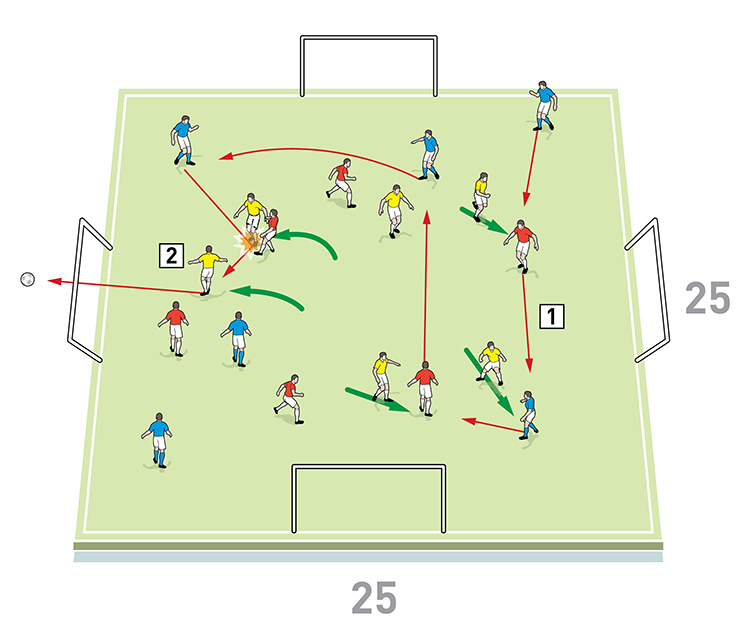
2. If the yellows win the ball, they should try to score in one of the goals under pressure from the other two teams
Each team plays as the pressing team for five games of decreasing lengths, rotating roles as follows…
Small-sided games
We set up an area of 36x44 yards (the size of two penalty areas) with a goal and a goalkeeper at each end. We’re using three teams of six outfield players. Two teams play against each other and the players of the third team are positioned around the outside of the pitch and they play for the team in possession, as shown [4]. The outside players are limited to one-touch passing. Play three-minute games and rotate teams regularly.
4
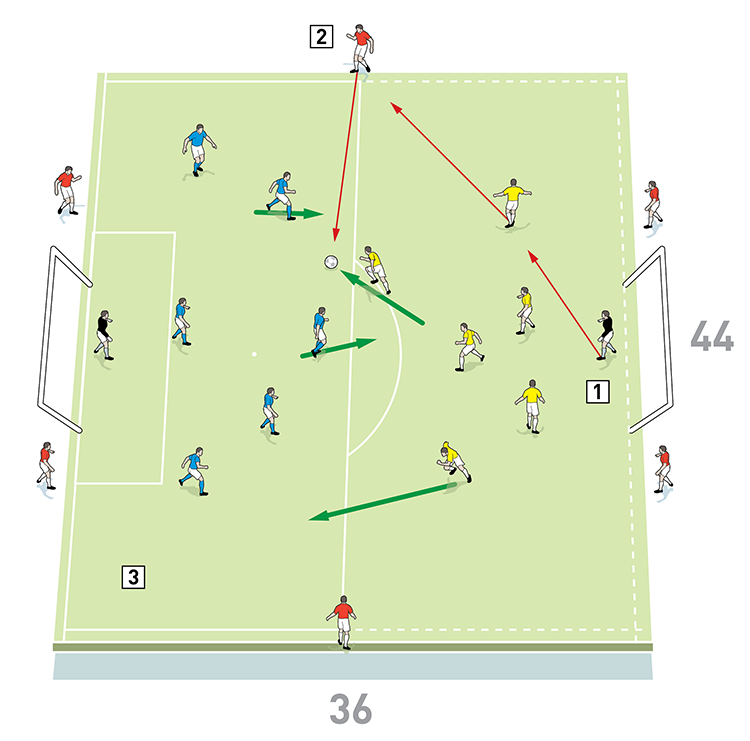
2. The reds are lined up around the edge of the pitch and play for the team in possession. They are limited to one touch
3. After each three-minute game, rotate teams
How do I progress the session?
The various elements of the session can be amended to meet the required technical and physical outcomes. The techniques on the Technical Practice can be made less or more difficult, while the Crossing & Finishing practice can have restrictions on the number of touches or the type of finish. The possession element of the Four Goal Game can see touches reduced from ‘all in’ to one-touch depending on the standard of the players.
The small sided game can add rules such as all players must be in the opposing half for a goal to count, thus increasing the mental and physical challenge.
What are the key things to look out for?
The players are working under duress and the impact of fatigue must be noted, but it is vital to focus as much on the technical execution as it is to look at the physical outcomes. We need to see that the players can complete the necessary technical demands whilst under physical duress.
What are the typical mistakes that players might make and how do I avoid them?
Players typically view this as a ‘working’ session and can often allow their technical focus to drift. Ensure standards are maintained for all aspects of the session. The coaches must also ensure their focus is on all the required outcomes of the session.
Editor's Picks
Attacking transitions
Deep runs in the final third
Using the goalkeeper in build-up play
Intensive boxes drill with goals
Penetrating the final third
Creating and finishing
My philosophy
Pressing initiation
Compact team movement
Coaches' Testimonials

Alan Pardew

Arsène Wenger

Brendan Rodgers

Carlos Carvalhal

José Mourinho

Jürgen Klopp

Pep Guardiola

Roy Hodgson

Sir Alex Ferguson

Steven Gerrard
Coaches' Testimonials

Gerald Kearney, Downtown Las Vegas Soccer Club

Paul Butler, Florida, USA

Rick Shields, Springboro, USA

Tony Green, Pierrefonds Titans, Quebec, Canada
Join the world's leading coaches and managers and discover for yourself one of the best kept secrets in coaching. No other training tool on the planet is written or read by the calibre of names you’ll find in Elite Soccer.
In a recent survey 92% of subscribers said Elite Soccer makes them more confident, 89% said it makes them a more effective coach and 91% said it makes them more inspired.
Get Monthly Inspiration
All the latest techniques and approaches
Since 2010 Elite Soccer has given subscribers exclusive insight into the training ground practices of the world’s best coaches. Published in partnership with the League Managers Association we have unparalleled access to the leading lights in the English leagues, as well as a host of international managers.
Elite Soccer exclusively features sessions written by the coaches themselves. There are no observed sessions and no sessions “in the style of”, just first-hand advice delivered direct to you from the coach.









